Investigating the Effect of COVID-19 on Driver Behavior and Road Safety: A Naturalistic Driving Study in Malaysia
Abstract
:1. Introduction
2. Method
2.1. Phase I: Data Acquisition System
2.2. Phase II: Data Collection
2.3. Phase III: Statistical Analysis
3. Results
4. Discussion
5. Conclusions
Author Contributions
Funding
Institutional Review Board Statement
Informed Consent Statement
Data Availability Statement
Conflicts of Interest
References
- Ciotti, M.; Ciccozzi, M.; Terrinoni, A.; Jiang, W.-C.; Wang, C.-B.; Bernardini, S. The COVID-19 pandemic. Crit. Rev. Clin. Lab. Sci. 2020, 57, 365–388. [Google Scholar] [CrossRef] [PubMed]
- Zhu, N.; Zhang, D.; Wang, W.; Li, X.; Yang, B.; Song, J.; Zhao, X.; Huang, B.; Shi, W.; Lu, R.; et al. A novel coronavirus from patients with pneumonia in China, 2019. N. Engl. J. Med. 2020, 382, 727–733. [Google Scholar] [CrossRef] [PubMed]
- WHO. WHO Director-General’s Opening Remarks at the Media Briefing on COVID-19-11 March 2020. Available online: https://www.who.int/dg/speeches/detail/who-director-general-s-opening-remarks-at-themedia-briefing-on-covid-19---11-march-2020 (accessed on 1 March 2022).
- The Official Malaysia Government Website for Data and Insights on COVID-19. Available online: https://covidnow.moh.gov.my/ (accessed on 1 March 2022).
- Sharifi, A.; Khavarian-Garmsir, A.R. The COVID-19 pandemic: Impacts on cities and major lessons for urban planning, design, and management. Sci. Total Environ. 2020, 749, 142391. [Google Scholar] [CrossRef] [PubMed]
- Michelaraki, E.; Sekadakis, M.; Katrakazas, C.; Ziakopoulos, A.; Yannis, G. A four-country comparative overview of the impact of COVID-19 on traffic safety behavior. In Proceedings of the 10th International Congress on Transportation Research, Future Mobility and Resilient Transport: Transition to Innovation—ICTR 2021, Rhodes, Greece, 1–3 September 2021. [Google Scholar]
- Katrakazas, C.; Michelaraki, E.; Sekadakis, M.; Yannis, G. A descriptive analysis of the effect of the COVID-19 pandemic on driving behavior and road safety. Transp. Res. Interdiscip. Perspect. 2020, 7, 100186. [Google Scholar] [CrossRef] [PubMed]
- Katrakazas, C.; Michelaraki, E.; Sekadakis, M.; Ziakopoulos, A.; Kontaxi, A.; Yannis, G. Identifying the impact of the COVID-19 pandemic on driving behavior using naturalistic driving data and time series forecasting. J. Saf. Res. 2021, 78, 189–202. [Google Scholar] [CrossRef] [PubMed]
- Stavrinos, D.; McManus, B.; Mrug, S.; He, H.; Gresham, B.; Albright, M.G.; Svancara, A.M.; Whittington, C.; Underhill, A.; White, D.M. Adolescent driving behavior before and during restrictions related to COVID-19. Accid. Anal. Prev. 2020, 144, 105686. [Google Scholar] [CrossRef] [PubMed]
- Dong, X.; Xie, K.; Yang, H. How did COVID-19 impact driving behaviors and crash severity? A multigroup structural equation modeling. Accid. Anal. Prev. 2022, 172, 106687. [Google Scholar] [CrossRef] [PubMed]
- Corcoba, V.; Paneda, X.G.; Melendi, D.; Garcia, R.; Pozueco, L.; Paiva, S. COVID-19 and Its Effects on the Driving Style of Spanish Drivers. IEEE Access. 2021, 9, 146680–146690. [Google Scholar] [CrossRef]
- Gupta, M.; Pawar, N.M.; Velaga, N.R. Impact of lockdown and change in mobility patterns on road fatalities during COVID-19 pandemic. Transp. Lett. 2021, 13, 447–460. [Google Scholar] [CrossRef]
- Lopetrone, E.; Biondi, F.N. On the Effect of COVID-19 on Drivers’ Behavior: A Survey Study. Transp. Res. Rec. 2022, 1–9. [Google Scholar] [CrossRef]
- Vanlaar, W.; Woods-Fry, H.; Barrett, H.; Lyon, C.; Brown, S.; Wicklund, C.; Robertson, R. The impact of COVID-19 on road safety in Canada and the United States. Accid. Anal. Prev. 2021, 160, 106324. [Google Scholar] [CrossRef] [PubMed]
- Wang, W.; Miao, W.; Liu, Y.; Deng, Y.; Cao, Y. The impact of COVID-19 on the ride-sharing industry and its recovery: Causal evidence from China. Transp. Res. Part A Policy Pract. 2022, 155, 128–141. [Google Scholar] [CrossRef] [PubMed]
- Al-Hussein, W.A.; Kiah, M.L.M.; Yee, L.; Zaidan, B.B. A systematic review on sensor-based driver behaviour studies: Coherent taxonomy, motivations, challenges, recommendations, substantial analysis and future directions. PeerJ Comput. Sci. 2021, 7, e632. [Google Scholar] [CrossRef] [PubMed]
- Al-Hussein, W.A.; Yee, L.; Kiah, M.L.M.; Zaidan, B.B. Driver behavior profiling and recognition using deep-learning methods: In accordance with traffic regulations and experts guidelines. Int. J. Environ. Res. Public Health 2022, 19, 1470. [Google Scholar] [CrossRef] [PubMed]
- Mohammed, A.; Yazid, M.R.M.; Zaidan, B.B.; Zaidan, A.A.; Garfan, S.; Zaidan, R.A.; Ameen, H.A.; Kareem, Z.H.; Malik, R.Q. A Landscape of Research on Bus Driver Behavior: Taxonomy, Open Challenges, Motivations, Recommendations, Limitations, and Pathways Solution in Future. IEEE Access 2021, 9, 139896–139927. [Google Scholar] [CrossRef]
- Molloy, J.; Tchervenkov, C.; Schatzmann, T.; Schoeman, B.; Hintermann, B.; Axhausen, K.W. MOBIS-COVID19/25: Results as of 19/10/2020 (Post-Lockdown); Creative Commons: Mountain View, CA, USA, 2020. [Google Scholar]
- Aktay, A.; Bavadekar, S.; Cossoul, G.; Davis, J.; Desfontaines, D.; Fabrikant, A.; Gabrilovich, E.; Gadepalli, K.; Gipson, B.; Guevara, M.; et al. Google COVID-19 community mobility reports: Anonymization process description (version 1.1). arXiv 2020, arXiv:2004.04145. [Google Scholar]
- Tang, K.H.D. Movement control as an effective measure against Covid-19 spread in Malaysia: An overview. J. Public Health 2022, 30, 583–586. [Google Scholar] [CrossRef] [PubMed]
- Al-Hussein, W.A.; Kiah, M.L.M.; Yee, L.; Zaidan, B.B. Investigating the Effect of Social and Cultural Factors on Drivers in Malaysia: A Naturalistic Driving Study. Int. J. Environ. Res. Public Health 2021, 18, 11740. [Google Scholar] [CrossRef] [PubMed]
- Pallant, J. Survival Manual. A Step by Step Guide to Data Analysis Using SPSS; McGraw-Hill Education: Berkshire, UK, 2013; Volume 4. [Google Scholar]
- Jun, J.; Ogle, J.; Guensler, R. Relationships between crash involvement and temporal-spatial driving behavior activity patterns: Use of data for vehicles with global positioning systems. Transp. Res. Rec. 2007, 2019, 246–255. [Google Scholar] [CrossRef]
- Wang, J.; Xu, W.; Fu, T.; Gong, H.; Shangguan, Q.; Sobhani, A. Modeling aggressive driving behavior based on graph construction. Transp. Res. Part C Emerg. Technol. 2022, 138, 103654. [Google Scholar] [CrossRef]


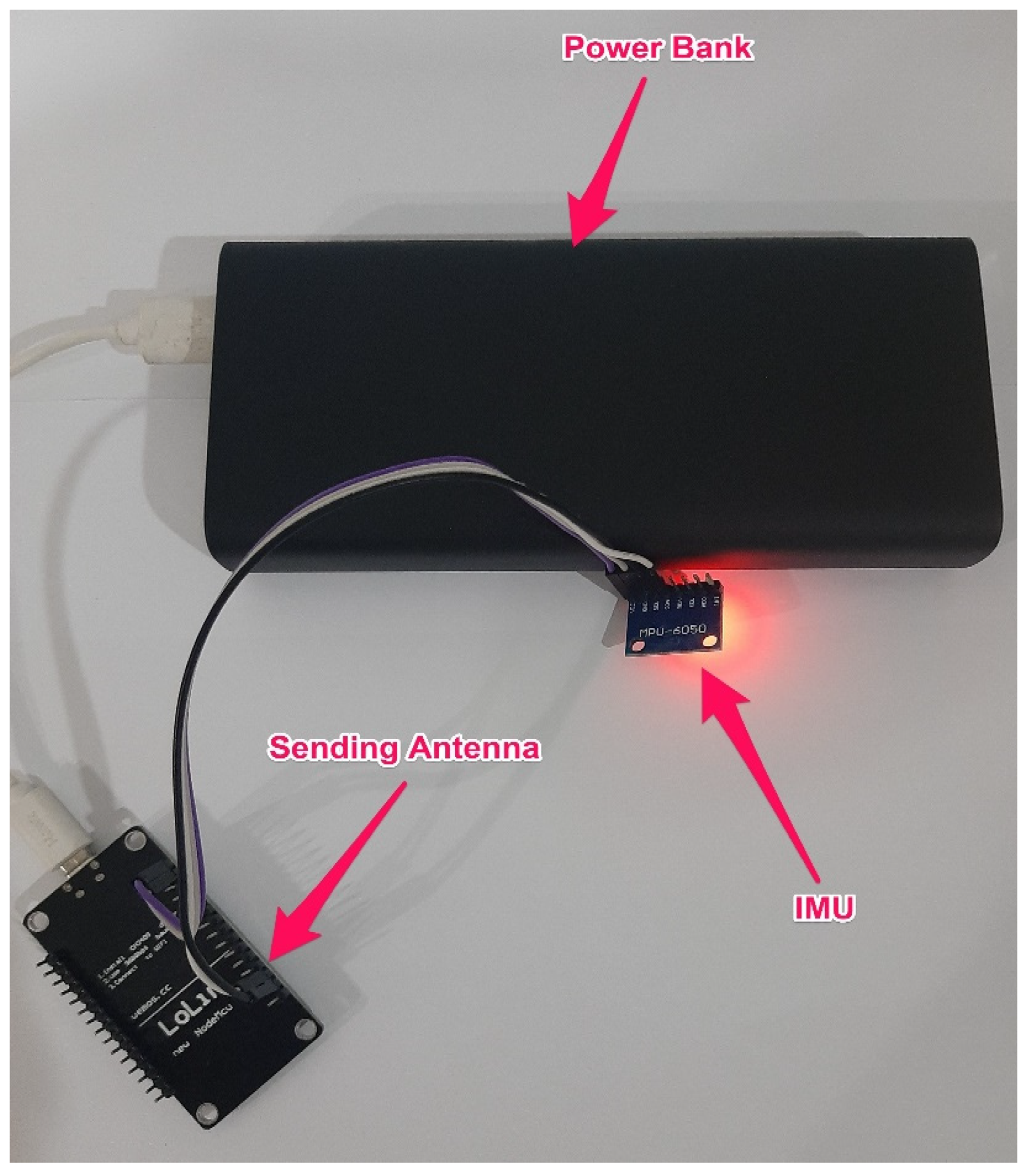
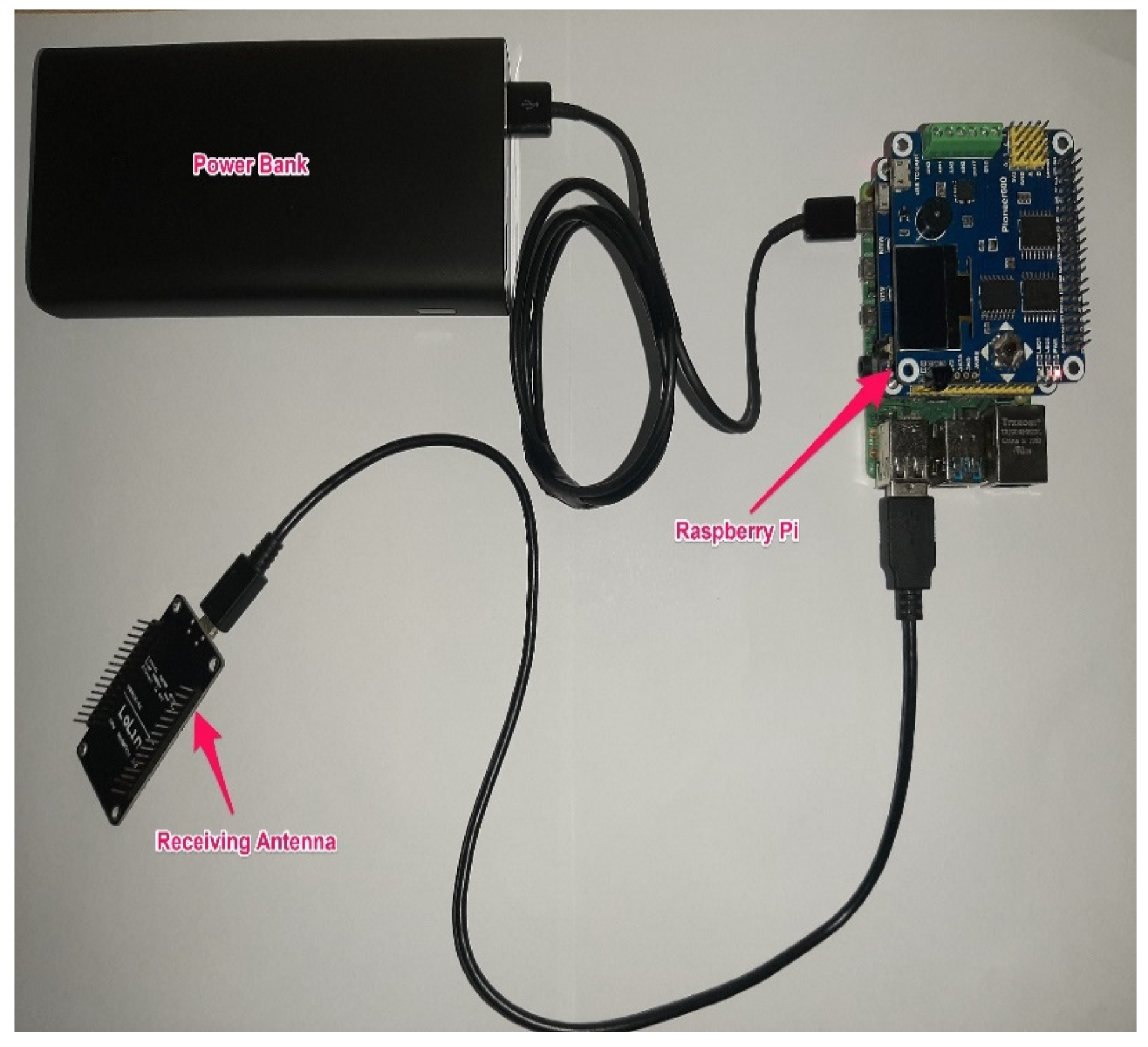
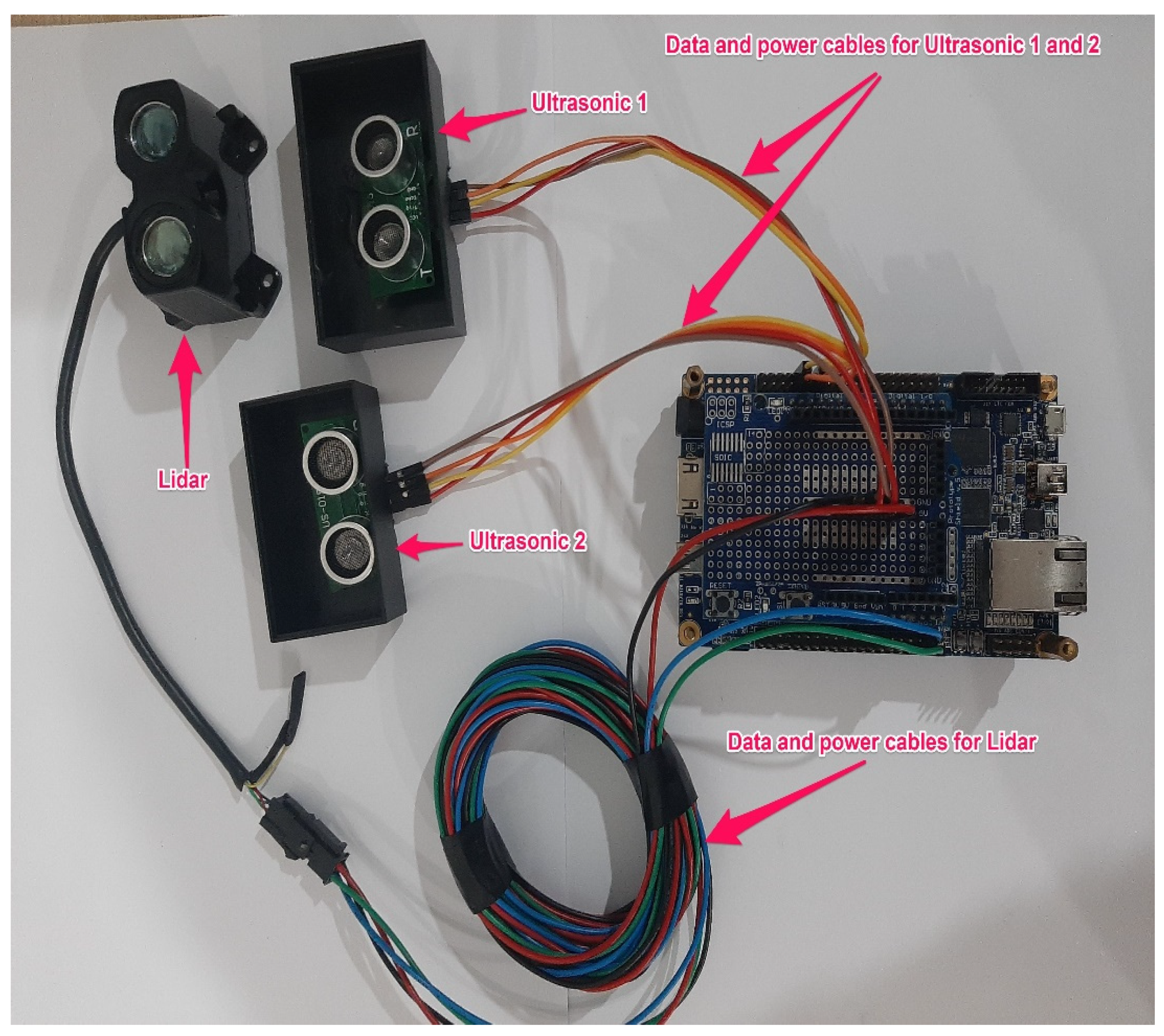
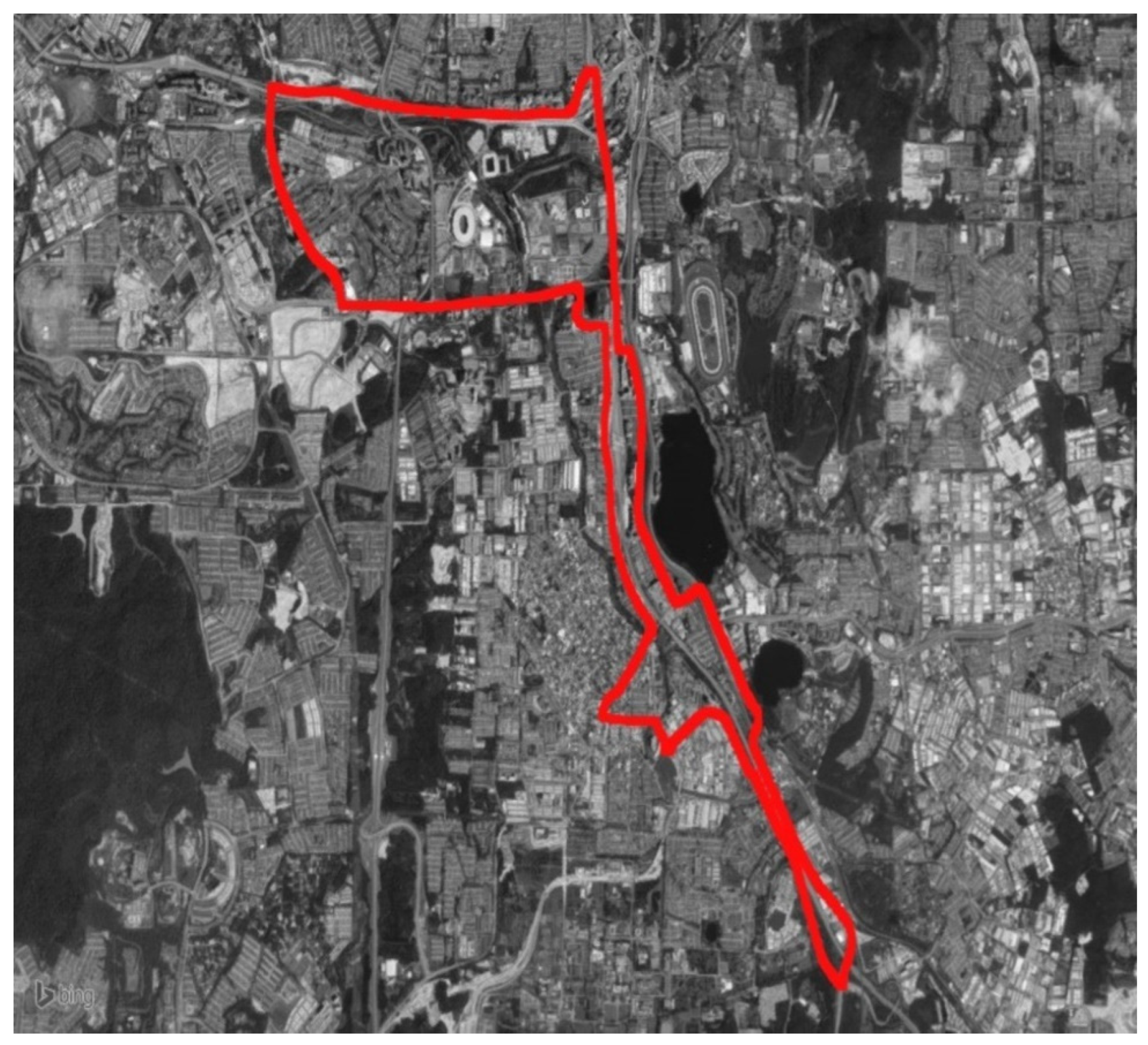
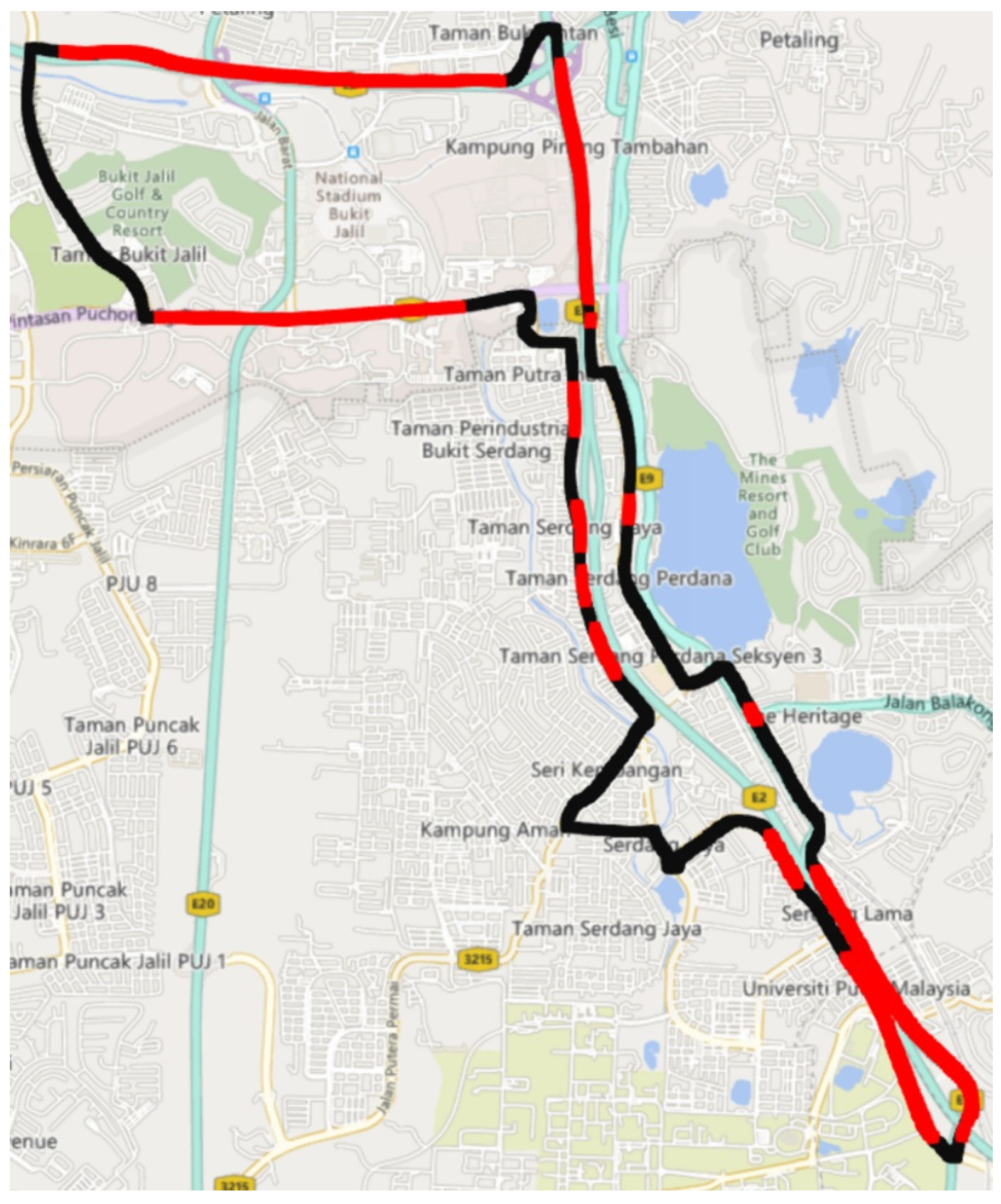
| Parameter | Criteria | Status |
|---|---|---|
| Speed | ≤speed limit | Safe |
| >speed limit | Aggressive | |
| Distance to vehicle ahead | ≥4 m for every 15 km/h | Safe |
| <4 m for every 15 km/h | Aggressive | |
| Acceleration | <3.5 m/s2 | Safe |
| ≥3.5 m/s2 | Aggressive | |
| Deceleration | >−5.5 m/s2 | Safe |
| ≤−5.5 m/s2 | Aggressive | |
| Steering | If z-score for the change in yaw angle per second is between 1σ and −1σ | Safe |
| If z-score for the change in yaw angle per second is above 1σ or below −1σ | Aggressive |
| Distance to Vehicle Ahead | Speed | Acceleration | Deceleration | Steering | |
|---|---|---|---|---|---|
| Pre-COVID | A = 1107.09 cm MAE = 385.86 | A = 45.41 kmph MAE = 208.93 | A= 0.64 m/s2 MAE = 0.53 | A = −0.78 m/s2 MAE = 0.26 | A = 9.31 MAE = 132.53 |
| During COVID | A = 1107.05 cm MAE = 386.06 | A = 46.66 kmph MAE = 216.73 | A= 0.64 m/s2 MAE = 0.60 | A = −0.78 m/s2 MAE = 0.30 | A = 9.28 MAE = 139.96 |
| Post-COVID | A = 1107.05 cm MAE = 386.33 | A = 45.26 kmph MAE = 209.20 | A= 0.65 m/s2 MAE = 0.53 | A = −0.79 m/s2 MAE = 0.26 | A = 9.30 MAE = 132.33 |
| A = average MAE = mean aggressive events | |||||
| Variable | Group | N | Mean | F | Sig. | Conclusion |
|---|---|---|---|---|---|---|
| Distance to vehicle ahead | Pre-COVID | 15 | 1067.16 | 0 | 1.0 | No differences. |
| (Mean) | During COVID | 15 | 1066.4 | |||
| Post-COVID | 15 | 1066.46 | ||||
| Total | 45 | 1066.67 | ||||
| Speed | Pre-COVID | 15 | 42.6 | 0.002 | 0.998 | No differences. |
| (Mean) | During COVID | 15 | 42.6 | |||
| Post-COVID | 15 | 42.5 | ||||
| Total | 45 | 42.6 | ||||
| Acceleration | Pre-COVID | 15 | 0.65 | 0.253 | 0.778 | No differences. |
| (Mean) | During COVID | 15 | 0.64 | |||
| Post-COVID | 15 | 0.66 | ||||
| Total | 45 | 0.65 | ||||
| Deceleration | Pre-COVID | 15 | −0.767 | 0.101 | 0.904 | No differences. |
| (Mean) | During COVID | 15 | −0.733 | |||
| Post-COVID | 15 | −0.733 | ||||
| Total | 45 | −0.771 | ||||
| Steering | Pre-COVID | 15 | 9.187 | 0.001 | 0.999 | No differences. |
| (Mean) | During COVID | 15 | 9.180 | |||
| Post-COVID | 15 | 9.193 | ||||
| Total | 45 | 9.187 | ||||
| Distance to vehicle ahead | Pre-COVID | 15 | 458.8 | 0 | 1.0 | No differences. |
| (Aggressive events) | During COVID | 15 | 458.6 | |||
| Post-COVID | 15 | 458.9 | ||||
| Total | 45 | 458.8 | ||||
| Speed | Pre-COVID | 15 | 187.67 | 0.026 | 0.974 | No differences. |
| (Aggressive events) | During COVID | 15 | 192.87 | |||
| Post-COVID | 15 | 188.13 | ||||
| Total | 45 | 189.56 | ||||
| Acceleration | Pre-COVID | 15 | 0.4 | 0 | 1.0 | No differences. |
| (Aggressive events) | During COVID | 15 | 0.4 | |||
| Post-COVID | 15 | 0.4 | ||||
| Total | 45 | 0.4 | ||||
| Deceleration | Pre-COVID | 15 | 0.27 | 0 | 1 | No differences. |
| (Aggressive events) | During COVID | 15 | 0.27 | |||
| Post-COVID | 15 | 0.27 | ||||
| Total | 45 | 0.27 | ||||
| Steering | Pre-COVID | 15 | 141.8 | 0.131 | 0.878 | No differences. |
| (Aggressive events) | During COVID | 15 | 145.6 | |||
| Post-COVID | 15 | 141.33 | ||||
| Total | 45 | 142.91 |
| Variable | Group | N | Mean | F | Sig. | Conclusion |
|---|---|---|---|---|---|---|
| Distance to vehicle ahead | Pre-COVID | 15 | 1147.027 | 0 | 1.0 | No differences. |
| (Mean) | During COVID | 15 | 1147.700 | |||
| Post-COVID | 15 | 1147.647 | ||||
| Total | 45 | 1147.458 | ||||
| Speed | Pre-COVID | 15 | 48.27 | 1.469 | 0.242 | No differences. |
| (Mean) | During COVID | 15 | 50.680 | |||
| Post-COVID | 15 | 47.980 | ||||
| Total | 45 | 48.956 | ||||
| Acceleration | Pre-COVID | 15 | 0.633 | 0.091 | 0.913 | No differences. |
| (Mean) | During COVID | 15 | 0.633 | |||
| Post-COVID | 15 | 0.640 | ||||
| Total | 45 | 0.636 | ||||
| Deceleration | Pre-COVID | 15 | −0.793 | 0.333 | 0.718 | No differences. |
| (Mean) | During COVID | 15 | −0.787 | |||
| Post-COVID | 15 | −0.807 | ||||
| Total | 45 | −0.796 | ||||
| Steering | Pre-COVID | 15 | 9.440 | 0.016 | 0.984 | No differences. |
| (Mean) | During COVID | 15 | 9.387 | |||
| Post-COVID | 15 | 9.420 | ||||
| Total | 45 | 9.416 | ||||
| Distance to vehicle ahead | Pre-COVID | 15 | 312.87 | 1.055 | 1.0 | No differences. |
| (Aggressive events) | During COVID | 15 | 313.53 | |||
| Post-COVID | 15 | 313.73 | ||||
| Total | 45 | 313.38 | ||||
| Speed | Pre-COVID | 15 | 230.20 | 0.084 | 0.920 | No differences. |
| (Aggressive events) | During COVID | 15 | 240.60 | |||
| Post-COVID | 15 | 230.27 | ||||
| Total | 45 | 233.69 | ||||
| Acceleration | Pre-COVID | 15 | 0.67 | 0.096 | 0.909 | No differences. |
| (Aggressive events) | During COVID | 15 | 0.8 | |||
| Post-COVID | 15 | 0.87 | ||||
| Total | 45 | 0.71 | ||||
| Deceleration | Pre-COVID | 15 | 0.27 | 0.034 | 0.966 | No differences. |
| (Aggressive events) | During COVID | 15 | 0.33 | |||
| Post-COVID | 15 | 0.27 | ||||
| Total | 45 | 0.29 | ||||
| Steering | Pre-COVID | 15 | 123.27 | 0.844 | 0.437 | No differences. |
| (Aggressive events) | During COVID | 15 | 134.33 | |||
| Post-COVID | 15 | 123.33 | ||||
| Total | 45 | 126.98 |
| Variable | Group | N | Mean | F | Sig. | Conclusion |
|---|---|---|---|---|---|---|
| Distance to vehicle ahead | Pre-COVID | 10 | 980.78 | 0 | 1.0 | No differences. |
| (Mean) | During COVID | 10 | 980.22 | |||
| Post-COVID | 10 | 980.03 | ||||
| Total | 30 | 980.34 | ||||
| Speed | Pre-COVID | 10 | 41.99 | 0.002 | 0.998 | No differences. |
| (Mean) | During COVID | 10 | 41.37 | |||
| Post-COVID | 10 | 41.94 | ||||
| Total | 30 | 41.76 | ||||
| Acceleration | Pre-COVID | 10 | 0.64 | 0.253 | 0.778 | No differences. |
| (Mean) | During COVID | 10 | 0.64 | |||
| Post-COVID | 10 | 0.65 | ||||
| Total | 30 | 0.64 | ||||
| Deceleration | Pre-COVID | 10 | −0.76 | 0.071 | 0.931 | No differences. |
| (Mean) | During COVID | 10 | −0.77 | |||
| Post-COVID | 10 | −0.77 | ||||
| Total | 30 | −0.76 | ||||
| Steering | Pre-COVID | 10 | 8.90 | 0.013 | 0.987 | No differences. |
| (Mean) | During COVID | 10 | 8.90 | |||
| Post-COVID | 10 | 8.87 | ||||
| Total | 30 | 8.89 | ||||
| Distance to vehicle ahead | Pre-COVID | 10 | 502.50 | 0 | 1.0 | No differences. |
| (Aggressive events) | During COVID | 10 | 502.30 | |||
| Post-COVID | 10 | 502.20 | ||||
| Total | 30 | 502.33 | ||||
| Speed | Pre-COVID | 10 | 208.20 | 0.026 | 0.974 | No differences. |
| (Aggressive events) | During COVID | 10 | 209.30 | |||
| Post-COVID | 10 | 208.50 | ||||
| Total | 30 | 208.67 | ||||
| Acceleration | Pre-COVID | 10 | 0.3 | 0 | 1.0 | No differences. |
| (Aggressive events) | During COVID | 10 | 0.3 | |||
| Post-COVID | 10 | 0.3 | ||||
| Total | 30 | 0.3 | ||||
| Deceleration | Pre-COVID | 10 | 0.10 | 0 | 1 | No differences. |
| (Aggressive events) | During COVID | 10 | 0.10 | |||
| Post-COVID | 10 | 0.10 | ||||
| Total | 30 | 0.10 | ||||
| Steering | Pre-COVID | 10 | 138.10 | 0.001 | 0.999 | No differences. |
| (Aggressive events) | During COVID | 10 | 138.10 | |||
| Post-COVID | 10 | 137.60 | ||||
| Total | 30 | 137.93 |
| Variable | Group | N | Mean | F | Sig. | Conclusion |
|---|---|---|---|---|---|---|
| Distance to vehicle ahead | Pre-COVID | 10 | 1194.85 | 0 | 1.0 | No differences. |
| (Mean) | During COVID | 10 | 1194.73 | |||
| Post-COVID | 10 | 1194.58 | ||||
| Total | 30 | 1194.72 | ||||
| Speed | Pre-COVID | 10 | 47.49 | 0.025 | 0.976 | No differences. |
| (Mean) | During COVID | 10 | 47.06 | |||
| Post-COVID | 10 | 47.27 | ||||
| Total | 30 | 47.27 | ||||
| Acceleration | Pre-COVID | 10 | 0.65 | 0.122 | 0.886 | No differences. |
| (Mean) | During COVID | 10 | 0.64 | |||
| Post-COVID | 10 | 0.65 | ||||
| Total | 30 | 0.647 | ||||
| Deceleration | Pre-COVID | 10 | −0.80 | 0.466 | 0.633 | No differences. |
| (Mean) | During COVID | 10 | −0.79 | |||
| Post-COVID | 10 | −0.81 | ||||
| Total | 30 | −0.80 | ||||
| Steering | Pre-COVID | 10 | 9.25 | 0.035 | 0.966 | No differences. |
| (Mean) | During COVID | 10 | 9.18 | |||
| Post-COVID | 10 | 9.27 | ||||
| Total | 30 | 9.23 | ||||
| Distance to vehicle ahead | Pre-COVID | 10 | 367.60 | 0 | 1.0 | No differences. |
| (Aggressive events) | During COVID | 10 | 368.00 | |||
| Post-COVID | 10 | 368.70 | ||||
| Total | 30 | 368.10 | ||||
| Speed | Pre-COVID | 10 | 182.70 | 0 | 1.0 | No differences. |
| (Aggressive events) | During COVID | 10 | 183.40 | |||
| Post-COVID | 10 | 182.80 | ||||
| Total | 30 | 182.97 | ||||
| Acceleration | Pre-COVID | 10 | 0.4 | 0 | 1.0 | No differences. |
| (Aggressive events) | During COVID | 10 | 0.4 | |||
| Post-COVID | 10 | 0.4 | ||||
| Total | 30 | 0.4 | ||||
| Deceleration | Pre-COVID | 10 | 0.10 | 0 | 1 | No differences. |
| (Aggressive events) | During COVID | 10 | 0.10 | |||
| Post-COVID | 10 | 0.10 | ||||
| Total | 30 | 0.10 | ||||
| Steering | Pre-COVID | 10 | 121.00 | 0.131 | 0.878 | No differences. |
| (Aggressive events) | During COVID | 10 | 121.50 | |||
| Post-COVID | 10 | 121.10 | ||||
| Total | 30 | 121.20 |
| Variable | Group | N | Mean | F | Sig. | Conclusion |
|---|---|---|---|---|---|---|
| Distance to vehicle ahead | Pre-COVID | 10 | 1145.65 | 0 | 1.0 | No differences. |
| (Mean) | During COVID | 10 | 1146.20 | |||
| Post-COVID | 10 | 1145.55 | ||||
| Total | 30 | 1146.13 | ||||
| Speed | Pre-COVID | 10 | 46.76 | 3.298 | 0.05 | Significant differences with relation to average speed. |
| (Mean) | During COVID | 10 | 51.56 | |||
| Post-COVID | 10 | 46.57 | ||||
| Total | 30 | 48.29 | ||||
| Acceleration | Pre-COVID | 10 | 0.64 | 0.123 | 0.885 | No differences. |
| (Mean) | During COVID | 10 | 0.64 | |||
| Post-COVID | 10 | 0.65 | ||||
| Total | 30 | 0.64 | ||||
| Deceleration | Pre-COVID | 10 | −0.78 | 0.089 | 0.915 | No differences. |
| (Mean) | During COVID | 10 | −0.78 | |||
| Post-COVID | 10 | −0.79 | ||||
| Total | 30 | −0.78 | ||||
| Steering | Pre-COVID | 10 | 9.79 | 0.001 | 0.999 | No differences. |
| (Mean) | During COVID | 10 | 9.77 | |||
| Post-COVID | 10 | 9.78 | ||||
| Total | 30 | 9.78 | ||||
| Distance to vehicle ahead | Pre-COVID | 10 | 287.50 | 0 | 1.0 | No differences. |
| (Aggressive events) | During COVID | 10 | 287.90 | |||
| Post-COVID | 10 | 288.10 | ||||
| Total | 30 | 287.83 | ||||
| Speed | Pre-COVID | 10 | 235.9 | 0.286 | 0.754 | No differences. |
| (Aggressive events) | During COVID | 10 | 257.50 | |||
| Post-COVID | 10 | 236.30 | ||||
| Total | 30 | 243.23 | ||||
| Acceleration | Pre-COVID | 10 | 0.90 | 0.117 | 0.890 | No differences. |
| (Aggressive events) | During COVID | 10 | 1.10 | |||
| Post-COVID | 10 | 0.90 | ||||
| Total | 30 | 0.97 | ||||
| Deceleration | Pre-COVID | 10 | 0.60 | 0.029 | 0.971 | No differences. |
| (Aggressive events) | During COVID | 10 | 0.70 | |||
| Post-COVID | 10 | 0.60 | ||||
| Total | 30 | 0.63 | ||||
| Steering | Pre-COVID | 10 | 138.50 | 5.578 | 0.009 | Significant differences with relation to steering. |
| (Aggressive events) | During COVID | 10 | 160.30 | |||
| Post-COVID | 10 | 138.30 | ||||
| Total | 30 | 145.70 |
| Dependent Variable | (I) | (J) | Sig. | Comment |
|---|---|---|---|---|
| Speed | Pre-COVID | During COVID | 0.093 | Young drivers drove more slowly before COVID. |
| (Mean) | Post-COVID | 0.996 | ||
| During COVID | Pre-COVID | 0.093 | Young drivers drove more quickly during COVID. | |
| Post-COVID | 0.078 | |||
| Post-COVID | Pre-COVID | 0.996 | No differences. | |
| During COVID | 0.078 | |||
| Steering | Pre-COVID | During COVID | 0.020 | Young drivers performed less aggressive steering before COVID. |
| (Aggressive events) | Post-COVID | 1.0 | ||
| During COVID | Pre-COVID | 0.020 | Young drivers performed more aggressive steering during COVID. | |
| Post-COVID | 0.019 | |||
| Post-COVID | Pre-COVID | 1.0 | Young drivers performed less aggressive steering after COVID. | |
| During COVID | 0.019 |
Publisher’s Note: MDPI stays neutral with regard to jurisdictional claims in published maps and institutional affiliations. |
© 2022 by the authors. Licensee MDPI, Basel, Switzerland. This article is an open access article distributed under the terms and conditions of the Creative Commons Attribution (CC BY) license (https://creativecommons.org/licenses/by/4.0/).
Share and Cite
Al-Hussein, W.A.; Li, W.; Por, L.Y.; Ku, C.S.; Alredany, W.H.D.; Leesri, T.; MohamadJawad, H.H. Investigating the Effect of COVID-19 on Driver Behavior and Road Safety: A Naturalistic Driving Study in Malaysia. Int. J. Environ. Res. Public Health 2022, 19, 11224. https://doi.org/10.3390/ijerph191811224
Al-Hussein WA, Li W, Por LY, Ku CS, Alredany WHD, Leesri T, MohamadJawad HH. Investigating the Effect of COVID-19 on Driver Behavior and Road Safety: A Naturalistic Driving Study in Malaysia. International Journal of Environmental Research and Public Health. 2022; 19(18):11224. https://doi.org/10.3390/ijerph191811224
Chicago/Turabian StyleAl-Hussein, Ward Ahmed, Wenshuang Li, Lip Yee Por, Chin Soon Ku, Wajdi Hamza Dawod Alredany, Thanakamon Leesri, and Huda Hussein MohamadJawad. 2022. "Investigating the Effect of COVID-19 on Driver Behavior and Road Safety: A Naturalistic Driving Study in Malaysia" International Journal of Environmental Research and Public Health 19, no. 18: 11224. https://doi.org/10.3390/ijerph191811224






